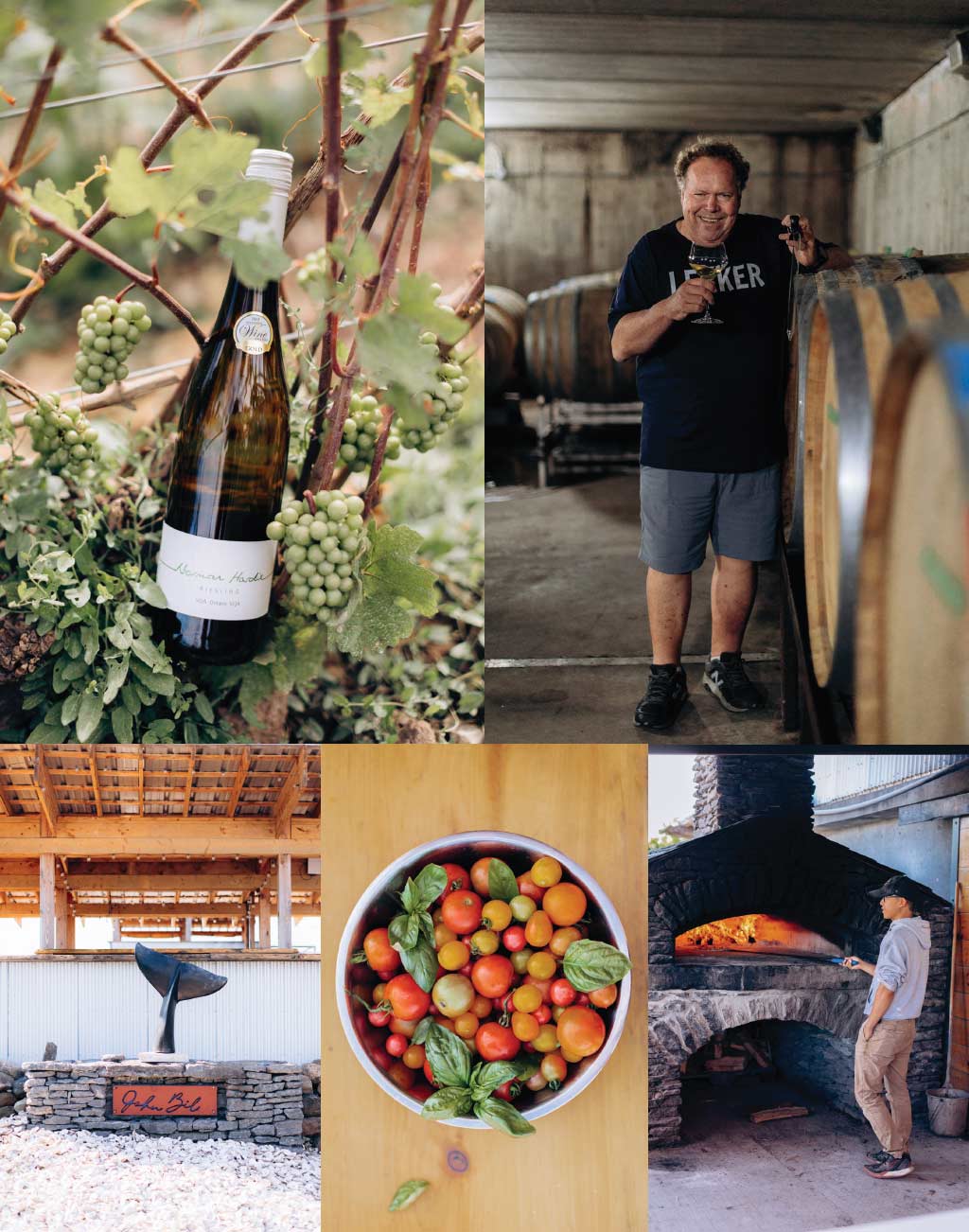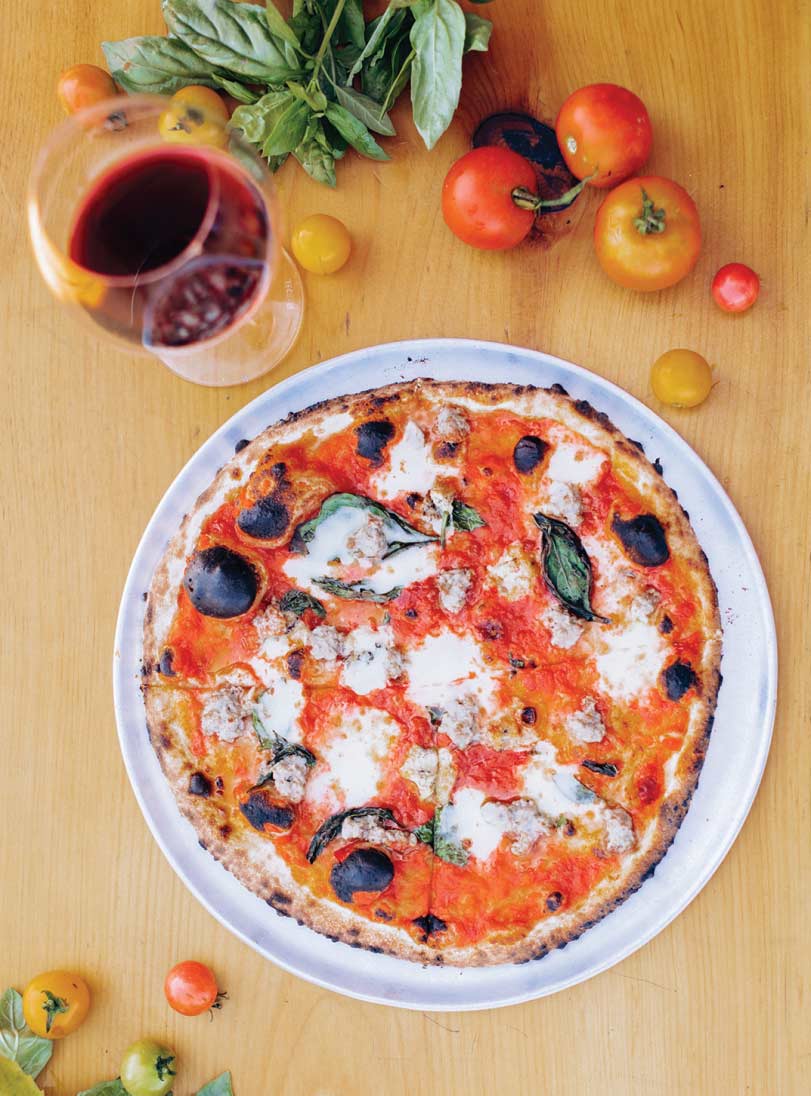


left to right: Stephanie Laing and Heather Coffey, Fiddlehead Farm; Angelo Bean; Mike McKenzie, Seed to Sausage
Pioneering Prince Edward County winemaker, Norman Hardie, prefers viticulture on the edge. It’s where exceptional things happen.
Winemaker Norm Hardie believes that what the early winemakers did in Prince Edward County was the catalyst for what the County is today: a lightning rod for tourists, foodies and oenophiles. “In 2004, Prince Edward County was nothing yet,” he reflects, “but I had a good understanding of soil, and I felt we could do something very special here because of the climate, the lake and that soil.”
“Everything we do is elemental,” says Norman Hardie. “Winemaking is simple, but greatness happens on the edge.” It happens in limestone, clay and chalky soils, and according to Hardie, this land tastes like Burgundy. “The County is one of only a few places in the world with soil like this.”
A winding driveway leads to Hardie’s rolling 45-acre property and an outdoor sculpture gallery displaying about 100 carvings by Chaka Chikodzi. Hardie donates the profits from each piece sold to a school he’s building in the artist’s village in Zimbabwe. “Education is the best antidote to poverty and corruption,” says Hardie, who immigrated to Canada from Botswana as a kid.
The simple schoolhouse will teach classes for boys and girls in Grades One and Two, and he hopes to have it running by January 2024. Hardie’s vision is democratic and nurturing. “We discussed uniforms,” says Hardie. “But having to buy a uniform means that some kids won’t be able to go to school, so I said no uniforms.” There will also be a farm as part of the school, which will produce enough food to provide all the kids with a meal. “This way,” he says, “at least we’ll know they are getting one serious meal a day.”
Hardie is invested in his roots, his community and his staff; he awards scholarships to his top performing employees. Indeed, the winery has launched the careers of many local and international winemakers and sommeliers. Beyond the sculptures lie gardens of heirloom tomatoes and basil. “It’s grown all naturally. We use the produce in the kitchen, but any extra goes to the Wellington Food Bank.”
Hardie’s open about what he’s gained and what he’s lost; about the good times and bad. A name – John Bil, inscribed on a monument – presides over thousands of oyster shells; a shrine to a friend, colleague and fishmonger who died too young. While another sign proudly proclaims: “Our wines are poured in over 30 Michelin Star restaurants across Europe.”
Spend even a little time here, with the spectacular views, the roaring trade, the accolades on the walls, and one could be forgiven for thinking he’s led a charmed existence, but he’s had his share of challenges.
In 2006 it rained nonstop in the County; in Niagara, 2021 was too wet for good grapes. And let’s not forget the pandemic. In 2015, the County was hit with a killing frost in late May and 80 percent of the grape crop was lost. And in 2018, responding to a newspaper article, the LCBO, SAQ (Quebec’s equivalent of the LCBO) and several restaurants dropped Hardie’s multi-award-winning wines.
“It was a really tough year as a company and as a person. But,” says Hardie, “all of my core team stayed with us, and we’ve made some big changes.” Six months after delisting Hardie’s wine, the LCBO restocked them. “It’s been a slower process getting back onto wine lists,” he admits. “But that’s happening too. We move forward and we’re in a better place than ever. Whatever we do, I want it to be the best. I want this to be the best place to work.”
Hardie practises viticulture raisonnée – reasonable viticulture – which is where organic, biodynamic and traditional wine-growing practices meet.
For instance, he ferments with the natural yeasts endemic to the property, while most wineries purchase commercial strains of yeast guaranteed to be the same, batch after batch. Wild yeasts impart unique flavours to the finished wine. He uses minimal amounts of sulphur in his wines. Sulphur is used widely to kill the bad bacteria that can ruin a batch of wine. “Only once have I exceeded the allowable threshold for sulphur in organic and biodynamic wines, and the wine was still well below the limit for conventional wines (200 ppm). Most of our wines tested at 20-60 ppm.” Hardie’s wines are also certified vegan. “We don’t use isinglass, egg white, or casein.”
His reds and whites spend time in French oak barrels, imported from a cooperage, Tonnellerie de Mercurey in Burgundy. The wood is tightly grained and lightly toasted and plays an important role in highlighting the wonderful minerality so typical of Chardonnay and Pinot Noir from Prince Edward County.
“My wines spend some time in stainless steel,” says Hardie, “but I age in barrels. Wood is best because like any living thing – and wine is a living thing – it needs to breathe, and wood allows for some oxygen exchange.”
He can’t produce the quantity of grapes he needs on his PEC farm, so he works with select growers in Niagara, controlling the picking, pruning and the viticultural practices. Once the fruit is harvested in Niagara, it’s shipped to the winery’s sorting table in PEC, where it’s hand-selected.
Hardie’s instincts are good. “I’ve tasted a lot of wine,” he says. “I know where the bullseye is, and because I’m the owner, I can make the kind of wines I want to make. If I was making wine for someone else, I’d be more conservative.”
“You know,” recalls Hardie. “It’s amazing what I’ve learned from my ex-wife. We were having dinner at her house and she had a very commercial wine on the table. I mentioned it, and she said, ‘Sometimes I just want to know what I’m going to get.’ My goal is to make consistently good wines. They won’t be exactly the same from vintage to vintage, but they have to be consistently good. For me, it’s about constantly building our reputation. One-offs don’t work. You have to deliver day in and day out.”
Dolce e Picante Pizza
Sweet and spicy is just the beginning with this pizza. It’s also creamy, sharp and fresh. Start with your favourite dough recipe or even store-bought. This freestyle recipe tells you what to use, but not how much, so dress this beauty with as much as you desire. If you have an outdoor pizza oven, lucky you! If not, crank up your convection oven to its hottest setting and don’t walk away, not even for a second!
Ingredients
1 pizza dough; homemade or store-bought
1 small can Italian San Marzano tomatoes, drained and puréed
spicy peperoncini oil to taste
liquid honey to taste
fior di latte mozzarella, torn or sliced
crumbled Fromagerie Montebello Rebellion blue cheese
Angelo Bean’s spicy sausage or nduja, removed from casing
fresh basil leaves, stems discarded
Directions
Preheat oven to at least 500F
* Roll pizza dough out onto a lightly floured board; stretch into roughly a 12” round.
* Spread ½ cup of the tomato sauce onto the dough to ½” from the edge.
* Drizzle the peperoncini oil and honey over the sauce to taste and spread to even out.
* Arrange both cheeses over the sauce, leaving space between the cheeses for the sausage.
* Add chunks of sausage between the cheeses and finish with fresh basil leaves.
* Cook for 90 seconds in a 900F pizza oven, turning a few times to cook evenly. In a conventional oven at 500-550F, cook for approximately 10-15 minutes, turning once or twice, until crust is golden and cheeses are melted.
Any leftover sauce can be kept for up to four days in the refrigerator, and used on pasta!
Stephanie Laing and Heather Coffey,
Fiddlehead Farm
Stephanie Laing and Heather Coffey of Fiddlehead Farm are on a mission: to feed their community and make their little corner of the world a better place one delicious and nutritious veggie at a time. Driven by the conviction that it is possible to build a sustainable local food system, the pair have been ecologically and sustainably raising vegetables on their 10-acre Prince Edward County farm – near Picton – since 2012. Members of Ecological Farmers Association of Ontario and a Community Supported Agriculture farm, they offer a wide variety of produce – from bok choy to hakuri turnip. The farm feeds local families all year round, while employing farming practices that promote biodiversity and rebuild soils. Their perfectly fresh and delicate mixed salad greens can be found on the menu at Norman Hardie’s winery.
“Heather and Stephanie’s lettuces are exquisitely fresh,” says Hardie. “And the texture! They’re crisp and bright with so much flavour and crunch. You simply can’t compare them to those boxes of mixed greens from the grocery store.”
Angelo Bean
Once a beloved presence on the floor at the LCBO’s posh Summerhill location, Angelo Bean knows a thing or two about wine and food. Bean was born and raised in Italy and immigrated to Canada at the age of 19. A carpenter by trade, he always felt drawn to the best and simplest foods of his homeland and his mother. He expressed this love through his Ontalia company, teaching rustic Italian fare with an ethos of Italian roots in local soil. In 2013 he began his professional salumi career in earnest, when he left Toronto for beautiful Bloomfield to open a cooking studio, from which he recently retired. Thankfully, he has not yet retired from crafting gorgeous cured meats, such as his wine-infused spicy sausage, which adds a kick to Norman Hardie’s Figlio dei Funghi pizza, as well as others. This sausage is a homage to a saucisson made in Burgundy, and includes the lees from Hardie’s Chardonnay.
“Angelo has been crafting salumi most of his life,” says Hardie. “And he’s a neighbour, so I’m very happy to have his salumi on my menu.”
Mike McKenzie,
Seed to Sausage
As a member of the Canadian military, Mike McKenzie travelled the world, serving our country and sampling cured meats from his many posts. Out of the military and back home, he began making salami and sausage in his garage. Local chefs soon sniffed him out and wanted his fantastic stuff, so he was forced to go legit, but not before working with and learning from some of the best chefs and salumi artisans in Europe.
His house-made, artisan-cured meats and sausages are crafted from mostly local, ethically raised, hormone- and antibiotic-free pork and duck, and include: duck prosciutto, Spanish lomo, speck, guanciale and Calabrese salami.
“You’ll find our Calabrese salami on Norm’s pizzas,” says McKenzie. “This is actually my favourite of all the cured meats I have made. It’s great in sandwiches, and on charcuterie boards, but when I see it on a pizza, in a rustic wood-fired oven like Norm’s, it really makes me happy.”
“I call it adult pepperoni!” says Hardie. “It’s as far from commercial pizza pepperoni as you can get!” seedtosausage.ca
Story by:
Signe Langford
Photography by:
Mira Knott




